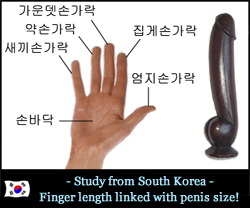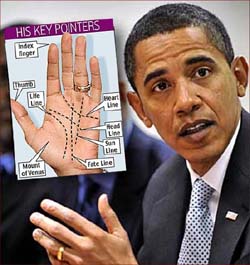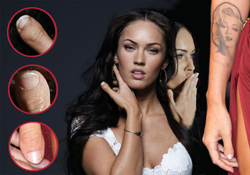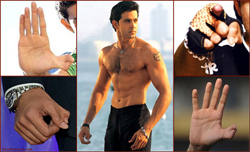Music is in the ring finger: hands of famous composers, palmistry & digit ratio research!
May 23, 2009

Back in 1968 Walter Sorell described in ‘The story of the human hand’ that musical ability had been linked to very long ring fingers for quite a while. Sorell illustrated this with handprints from composers as Alexander Tcherepnin and Edgar Varese, but his most powerful example in this context was the cast of Franz Listz’s right hand: see the picture above. One of the most striking features is the rather remarkable long ring finger in both hands. Interestingly, the hands of other famous pianists/composers in the history of classical music – such as Beethoven & Rubinstein (see the pictures below) – appear to have the same characteristic feature! But Chopin appears to have a more female-like ‘digit ratio’. Hand casts of Anton Rubinstein.
Hand casts of Frederic Chopin (left) & Ludwig van Beethoven (right).
In palmistry the ring finger is named after the sun god Apollo, who is known as the god of the muses because of his fine musicianship. Interestingly, a few years ago UK professor John Manning (Liverpool University) present a research (Slumming & Manning, 2000) which pointed out that the hands of male symphony musicians are characterised with a low ‘2D:4D finger ratio’ (2D = index finger; 4D = ring finger). Quote from Professor John T. Manning described in his book digit ratio:
|


 “This may be the first quantitative attempt to investigate the association between 2nd and 4th digit length and musical ability.”
“This may be the first quantitative attempt to investigate the association between 2nd and 4th digit length and musical ability.”
 Finger length & penis size linked!
Finger length & penis size linked! The hands of Barack Obama
The hands of Barack Obama Megan Fox thumbs – TRIBUTE
Megan Fox thumbs – TRIBUTE Hrithik Roshan thumbs – TRIBUTE
Hrithik Roshan thumbs – TRIBUTE Hand Reading Research!
Hand Reading Research! MultiPerspective Palm Reading
MultiPerspective Palm Reading
November 1, 2011 at 11:20 am
My theory is that the digit ratio has no causative association with musical aptitude, but rather that this is yet another example of high testosterone being associated with male success. The digit ratio is causatively associated with higher levels of testosterone, and high levels of testosterone are correlated with male success in every arena. Perhaps the higher levels of testosterone imbue greater aggression, drive, and ambition; which helps those so endowed to overcome obstacles and succeed in competative environments. At any rate, Chopin is the definitive negative proof.
July 14, 2011 at 9:33 pm
[…] Can anyone help me attempt to identify whose hand this might be? There are no inscriptions on the hand or on the base, and I can’t really tell what the medium is. I thought it might be a copy of another famous hand — Liszt, Chopin, Rubinstein, Beethoven, etc. — but I don’t think so. […]
December 20, 2010 at 7:11 pm
Great article. My grandmother told me that I was destined to play the piano after looking at my hands when I was only four years old. My ring finger is predominantly larger than my index finger. I truly enjoy composing and playing the piano! My Nana Pam was “spot-on.” – Lisa Linsky
October 12, 2010 at 7:05 pm
[…] length may also predict our musical ability, say the researchers. Also our athletic […]
August 27, 2010 at 12:24 pm
[…] length may also predict our musical ability, say the researchers. Also our athletic […]
August 1, 2010 at 11:01 pm
[…] hand cast at Madame Tussauds! • Hand cast of composer Frédéric Chopin! • Hand casts of the composers Liszt, Beethoven & Rubinstein • The hands of many other famous musicians & celebrites! • What is wrong with the hands […]
May 16, 2010 at 12:28 pm
[…] • Music is in the ring finger! […]
April 8, 2010 at 1:31 am
Chopin’s hand is on the right, and Beethoven’s is on the left in that picture.
April 8, 2010 at 1:58 am
Sorry David, your conclusion is incorrect.
Another colour photo of Chopin’s hand cast is presented at the wikipedia page about Chopin:
http://en.wikipedia.org/wiki/Fr%C3%A9d%C3%A9ric_Chopin, see section 1.7: ‘Death and funeral’.
Obviously the colour photo resembles with the left hand, not the right hand.
Right? 😉
February 2, 2010 at 5:29 pm
[…] and Edgar Varese, but the most powerful image he showed in this context was that of a cast of Franz Liszt’s right hand (Sorell 1968, 187). In this cast Liszt’s ring fingers is strikingly dominant in length, with […]
January 24, 2010 at 10:30 pm
My right hand ring finger and index finger are equal but left hand ring finger is longer than the index finger what does that mean?? I’m a pianist
January 26, 2010 at 1:39 pm
Hello Peiyun,
The equal length of the ring finger and index finger is a typical characteristic of the female hand (in males is the ring finger usually a bit longer than the pointer finger). But actually, even in females it is only natural to have a slightly longer ring finger.
So, this aspect of both of your hands probably only means that is is within the range of the ‘normal’. By the way, in terms of health, it is actually preferable to have fingers within the ‘normal’ range – but as a pianist you might have wanted to have the ‘long ring finger’. Right?
I hope you like this answer!?
Greetings from The Netherlands,
Martijn.
December 6, 2009 at 12:36 am
[…] Music is in the fingers! • Music & sports talent revealed by finger length measurement • Finger length moderates the […]
December 8, 2009 at 6:37 pm
If you want to speak to me about my digit ratio collection, I’d be glad to share it with you. Add me at maximiliangd@hotmail.com or something.
No, that isn’t the best picture of Tom Jones’ digit ratio, his fingers aren’t facing in a balanced way. I’m at school right now and have limited time to find it, but I can recall two or three pictures where there is a clear, palm-side shot.
Using calipers one can measure from the beginning of the knuckle to the end of the finger. The knuckle is a part of the proximal phalanges.
—
I have a few more minutes, I’ll search for the picture. Oh, and based on memory as well (I remember the majority of digit ratios I have seen), his right-hand ratio is lower than his left.
Not the best examples (I have better saved on a USB stick):
http://cache4.asset-cache.net/xc/87938028.jpg?v=1&c=IWSAsset&k=2&d=17A4AD9FDB9CF19375C05EF07E24E8D6E9FBE69610837351B01E70F2B3269972
Palm-side compared to other side:
It is a discrepancy worth noting.
December 20, 2009 at 12:37 am
Hello again Maximilian,
Thank you for sharing some examples in your collection of Tom’s hands.
The first photo is usable for making a ‘2D:4D digit ratio’ assessment of Tom’s hand (for, it is a ‘frontal’ impression of his hands and on that picture Tom’s fingers are almost fully stretched!):

I have used the 400% ZOOM-IN function of my windows explorer and found … a ‘2D:4D digit ratio’ of 0.90, which is definitely typical male-like!
However, I would not recommend to use the other 2 pictures for a ‘digit ratio’ assessment – simply because of that fact that in those picture his hands are not taken ‘frontal’, and his fingers are stretched neither.
Actually, because you have submitted those 2 picture for a ‘digit ratio’ assessment, I really would advice you to start all over again by reading how John Manning applies his finger studies.
For… again, it is by fact rather impossible to measure the 2D:4D digit ratio from the back of the hand – simply because compared to the inner side of the hand you have no clearly defined ‘marker’ at all to make measurement; for the inner side of the hand the mark is the ‘proximal crease’ between the finger and the palm, see:
– John Manning’s first book: page 1, 2 and 3 – where he describes how the 2d and 4d are measured;
– John Manning’s second book: page 8 and 9 (sorry, I have no link available – but you can also take a look at the picture at my blog: http://fingerlengthdigitratio.wordpress.com/ )
Feel free to post more pictures of Tom Jones’ hands – but please, only in case they really do present a better quality impression of his hands!
Thanks for your efforts so far!!
Good luck, Martijn.
December 20, 2009 at 5:02 am
I’ve read all of Manning’s books, and as I said I think the relationship will prove to be found in on the back-side of the hand with the bone as the marker and not the crease, palm-side finger length.
If you want to see an interestingly low digit ratio, palm-side, here:
December 20, 2009 at 5:04 am
I didn’t say he didn’t have a masculine digit ratio, it’s that his ratio is in truth lower if you judge the bone (ultiamtely the palm-side digit ratio does not fully represent one’s fingers).
By the way, what is your digit ratio? Mine are 0.89 on my left hand and 0.91 on my right hand.
December 2, 2009 at 12:25 am
Hello Maximilian,
Thank you for your comments!!
A few responses from my side:
1. In the scientific tradition that has evolved during the past decade (the ‘2D:4D digit ratio’ studies that have frequently been presented), the focuss has been on the inner side of the palm (so, while your comment about bone length & the hormones might be correct – I think studies so far have indicated that such an approach has brought any advances … feel free to correct me I you are aware of such studies!)
2. Thank you: I just found a picture of the inner side of Chopin’s hand … and you’re right: his ‘2D:4D digit ratio’ is very close to 1.00
This is a great picture: http://www.hunterian.gla.ac.uk/collections/object_month/left_hand/collection_index.shtml
(I will soon post an edit for this post – with a correction!!)
Greetings from The Netherlands,
Martijn.
December 2, 2009 at 6:32 pm
In doing my own studies (which amount to very little potency), I’ve found greater empirical correlation with the bone length difference. Sometimes the palm-side ratio is too low, or too high, and it always seems to be corrected when studying the top-side.
I’ve also read an article that suggested a new method of measurement that provided more accurate results, and it was closer to measuring the bone.
I think calipers should be used to measure the difference with the fingers placed at a 90 degree angle from the palm.
By the way, I have 1000s of pictures of various famous people and their digit ratios (with many shots of the same person for verification), and using Tom Jones (the singer), for example, you’ll find that his palm-side digit ratio does not correlate to his clearly high testosterone levels (hairy chest, deep voice), but rather the bone side does. Also, that picture of Franz Liszt’s hands isn’t as good as another cast that was made.
December 5, 2009 at 11:37 pm
Hello again Maximilian,
I for sure would love to hear more about your ‘digit ratio collection’!
But regarding the hands of Tom Jones, I think the following picture indicates that Tom Jones does have a typical ‘male-like’ 2D:4D finger ratio, see:

But maybe you have better quality pictures available?
Regards, Martijn
PS. By the way, HOW did you measure the bone length differences…??? (I am not aware that there is any specific indicator available at the the back-side of the hand – and I think one can only measure hand bone length throught X-ray techniques)
August 31, 2009 at 3:48 am
Chopin’s digit ratio appears to be 1.00 or 0.99.
August 31, 2009 at 7:09 pm
Hmm, first of all: thanks for your comment!
Sorry, but I think you made an incorrect observation, for by definition one can not MEASURE the ‘2D:4D digit ratio’ from the back of a palm. This illustration demonstrate how to measure the ‘digit ratio’:

PS. That picture is also available in this article:
http://www.handresearch.com/news/palmistry-digital-analogue-finger-length-new-chiromancy.htm
December 1, 2009 at 6:43 am
1. Digit ratio should be measured on the back as the hormones determine the length of the bone, and skin overlaps/etc… can obfuscate a palm ratio reading. I think digit ratio science will evolve towards measuring the bone as opposed to the fleshy underside.
2. Chopin’s digit ratio on both sides (there are pictures of his cast palm-side) is around 1.00.